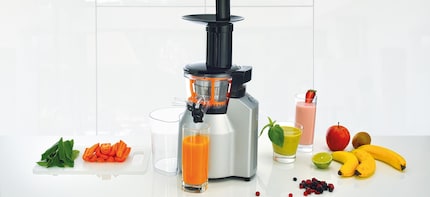
The big smoothie and juice test: Which appliance delivers the most vitamins?
Fruit and veg juices and smoothies are on everyone’s lips. The market has been flooded with countless gadgets using various technologies to make these highly appraised vitamin bombs. But how many nutrients do the various technologies get out of fruit and vegetables? This question was raised by Swiss consumer TV show “à bon entendeur” (ABE) – they tested blenders, centrifugal juicers and standard juicers.
Juice bars and smoothie shops are popping up like mushrooms all over Switzerland. What’s more, there has also been a drastic rise in home blending and juicing to create drinkable vitamin bombs. The market for making freshly-squeezed juices and smoothies is dominated by three technologies: blenders, centrifugal juicers (also called high-speed juicers) and regular juicers (aka slow juicers with cold-pressing technology).
So which technology produces juices with the highest vitamin content? To answer this question, ABE, the Swiss TV programme for consumer tests, gave the Swiss vitamin institute three appliances to test – each representing one of the technologies. In other words, it was not the appliances themselves that were scrutinized but the three different juice extracting methods available for home us.
The test:
Three medium to high-priced appliances were used for the test. For the centrifugal juicer, the smallest sieve was used. The ingredients: Two oranges, one apple, one celery stalk, one carrot and a handful of spinach – all organic. The ingredients were chosen for their high vitamin content and compatibility with the tested appliances.
The fruit and veg was washed and the oranges were peeled. All ingredients were cut into thirds in order to give all three kitchen appliances the exact same amount and composition to process.
Test criteria
The juices were analysed in a laboratory for the following nutrients:
- Vitamin C (main source: orange and apple)
- Folic acid (source: spinach and celery stalk)
- Vitamin B6 (from the carrot and spinach)
- Vitamin A (also known as beta-carotene contained in the spinach and carrot)
- Vitaming K (contained in spinach, celery stalk and in the carrot)
Test results
The laboratory tests showed no significant heating. In other words, none of the vitamins were lost due to heat development of the machines. The blender made a relatively thick juice or what you would call a smoothie. It used all the ingredients and left no waste. Both the centrifugal juicer and the regular juicer made very thin juices and left a considerable amount of pulp and fibre. These leftovers contained a lot of nutrients that went to waste. Therefore, the points went to the blender, which processed all ingredients. The smoothie contained 100% of all vitamins of the fruit and vegetables used. For this reason, the values of the juice made by the blender were used as a reference for the other two appliances.
Blender
Processing the ingredients in the blender leaves no waste. All the nutrients – that’s 100% of the vitamins – are used in the drink.

Centrifugal juicer
40% loss of fruit and veg, mainly due to the fact that a lot of fibre is not used in the drink. Compared to the blender results, this is how many vitamins remained in the drink:
- Vitamin C: 79%
- Folic acid: 63% (corresponds to weight loss)
- Vitamin B6: 40%
- Beta-Carotene: 57%
- Vitamin K: 27%

Juicer
Around 40% of the fruit and veg (waste, pulp and fibre) were lost in cold-pressed juices. The vitamin content compared to the blender results was as follows:
- Vitamin C: 100%
- Folic acid: 61% (corresponds to weight loss)
- Vitamin B6: 52%
- Beta-Carotene: 28%
- Vitamin K: 22%

Conclusion
Both the juicer and centrifugal juicer generated a relatively high vitamin loss – with the exception of vitamin C, which the slow juicer preserved 100% and the high speed juicer 80%. Therefore, the blender remains the best appliance when it comes to preserving the most vitamins. However, the thick consistency of the juice it makes is not everybody’s cup of tea or cup of juice. By adding water, it can be thinned down.
It can be concluded that fruit and vegetables generally contain the most nutrients when they are not made into juice. Furthermore, chewing stimulates the digestive process, which, in turn, increases the body’s utilisation of nutrients. Nonetheless, these healthy drinks are definitely a delicious and nutritious way of eating enough fruit and veg. According to the world health organization, the majority of the population does not eat the recommended daily amount of fruit and veg. So juices and smoothies are a good way to improve your nutrient intake.
Discovering foreign countries and cultures and tasting coffee or other delicacies is what I enjoy most when I travel. My home is decorated with little gems I find in thrift shops and at flea markets. When I’m having one of my big DIY moments, my creativity is unleashed. Both the mountains and the seaside restore my inner balance. With a snowboard or surfboard under my feet, I’m happy.